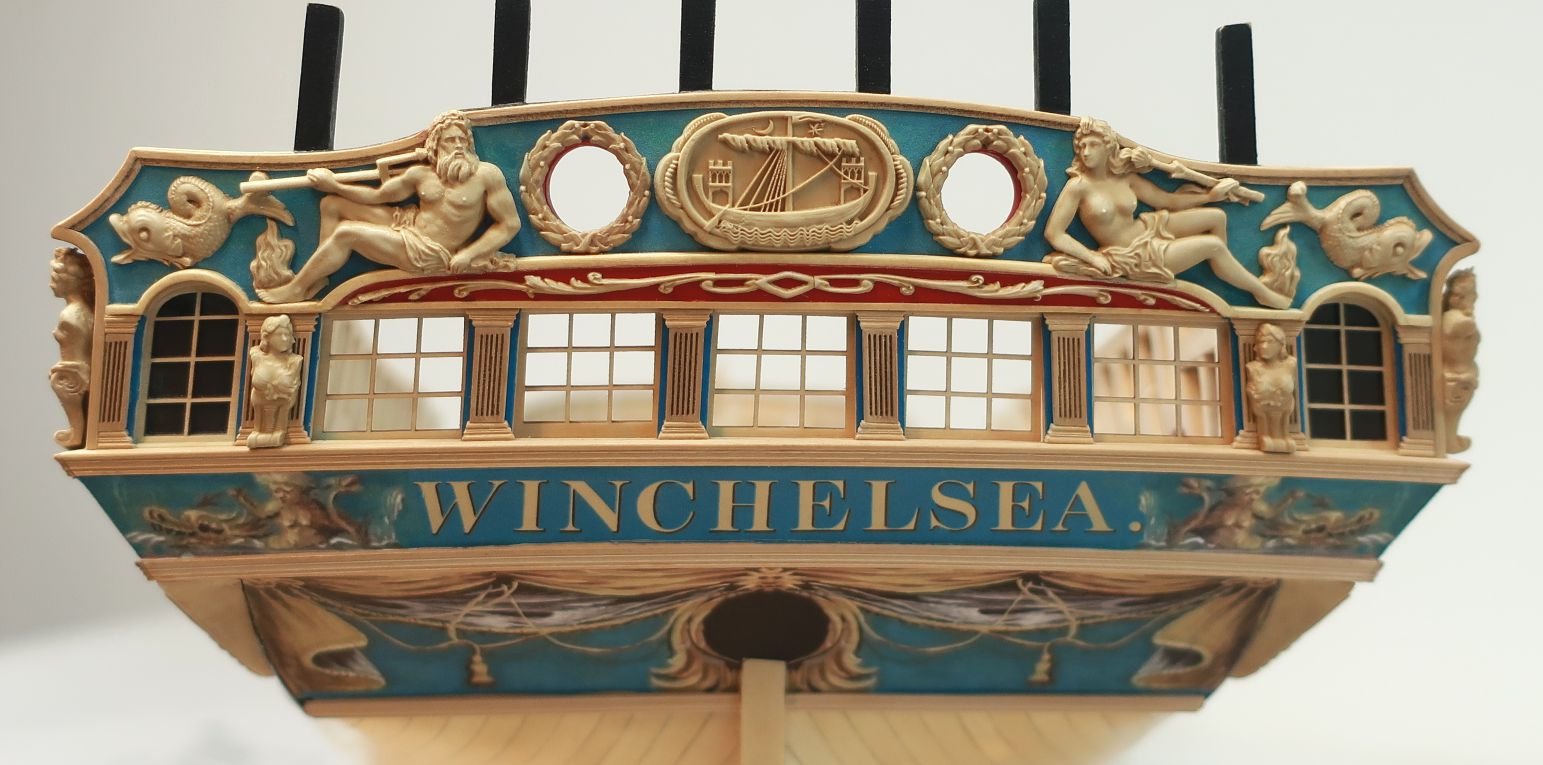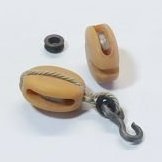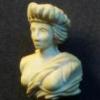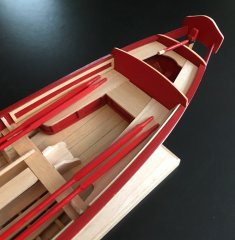Supplies of the Ship Modeler's Handbook are running out. Get your copy NOW before they are gone! Click on photo to order.
×
-
Posts
9,449 -
Joined
-
Last visited
Reputation Activity
-
 Chuck reacted to Ilhan Gokcay in Matthew 1497 by Ilhan Gokcay - FINISHED - Scale 1/50
Chuck reacted to Ilhan Gokcay in Matthew 1497 by Ilhan Gokcay - FINISHED - Scale 1/50
Finished the ladders on the deck using ready parts from stock. As the scale of these ladders are ok, with little modification and adjustment they fitted to their places.
-
 Chuck got a reaction from Obormotov in Completed Model Gallery is for Completed models only
Chuck got a reaction from Obormotov in Completed Model Gallery is for Completed models only
Two reminders ... The two Completed ship model gallery categories are for photos of completed models only. That's why they are named as such.
Second ... you must include the name of your model in the title of your gallery folder! Think about this one, folks -- when people search for a model in the gallery, what search term are they most likely going to use? That's right -- they're going to search for the name of a ship!
BTW, you don't have to put your name in the gallery title, since your folder and each of its images is stamped with your username.
PLEASE do not post albums of your work in progress! This gallery is meant to display the finished models and not become a second redundant build log. It just wont work!!!
Thanks in advance!
If you have photos of your models in progress please post them in a build log or other appropriate forum category.
Chuck
-
 Chuck reacted to augie in US Brig Syren by Augie - FINISHED - Model Shipways - 1:64
Chuck reacted to augie in US Brig Syren by Augie - FINISHED - Model Shipways - 1:64
OK, I don't know about you folks, but I'm all worn out on re-posting and looking at photos from the 18th Century. So I finally got out of this chair in front of the PC and did some (minor) work.
Here's the latest. The main topmast stays, backstays and preventer stays have been added. Finally converting 'rope' into lines that actually GO somewhere is a blast! I will be using Morope on everything with a diameter of .018" or larger, black for the standing rigging and beige for the running rigging. I picked up on the idea from Frank (riverboat) and really like the beige. The black, in my opinion, is not nearly as spectaclular. It does handle well though, provided you remember to apply some thin CA before you cut it. Otherwise it will unravel instantly.
Special note to Sjors------ No, I did not forget there are shrouds and ratlines on the upper foremast. All in good time, my friend
-
 Chuck reacted to augie in US Brig Syren by Augie - FINISHED - Model Shipways - 1:64
Chuck reacted to augie in US Brig Syren by Augie - FINISHED - Model Shipways - 1:64
Main mast upper shrouds and ratlines.
-
 Chuck reacted to jimbyr in Byrnes Rope Walk
Chuck reacted to jimbyr in Byrnes Rope Walk
Meredith
Great, it's all in the set up. I let the rope harden overnight. Move the post closer to the head for larger ropes if you have to.
The die size is also very important. Should be only a few thousandths larger than your finished rope
Jim
-
 Chuck got a reaction from thibaultron in 18th-century Pinnace by Chuck - FINISHED - 1/2" scale
Chuck got a reaction from thibaultron in 18th-century Pinnace by Chuck - FINISHED - 1/2" scale
Searching for inspiration, I came across some models for 18th century pinnaces. There were large 32 foot pinnaces and many smaller examples to look at. I was particularly fond of a model from the NMM in Greenwich. It was a model of a 21 foot long single banked pinnace from around 1750. It would make an excellent subject for this mini project. It has a paneled interior and some decorative merits. I found an original draft on the NMM website that was almost identical to this small 4 oared pinnace. Things were started to come together nicely.
I wasn’t necessarily thrilled with the color scheme shown on this model (pictured above) so I continued looking for some decorative alternatives. The pinnace was used a means of transport for a ship’s captain or other officers. It was not intended to be used to perform any other task. Tasks such as transporting water and other stores were normally left for the larger and heavier built boats like the longboat or launch. It was basically an officer’s private transport. It was designed to be rowed although larger pinnaces could be sailed. It wasn’t very seaworthy and was designed for primarily shore duties. After all, the officers did need a stylish way to get from their anchored ship to the dockyard. As such, the decorations were usually added much later at the officer’s and captain’s own expense.
So here is my journey in creating this scratch built model. The frames are basswood and everything else will be Boxwood.
You can download this full set of instructions below as a PDF. This was the prototype for the new Model Shipways kit.
Click Here to download this practicum
Chuck
-
 Chuck reacted to Trussben in 18th-century Pinnace by Chuck - FINISHED - 1/2" scale
Chuck reacted to Trussben in 18th-century Pinnace by Chuck - FINISHED - 1/2" scale
Yet another Passaro masterpiece, thanks for posting her again Chuck, wonderful to see.
Ben
-
 Chuck reacted to Rustyj in USF Confederacy by Rustyj - FINISHED
Chuck reacted to Rustyj in USF Confederacy by Rustyj - FINISHED
I will be posting the pictures of my completed scratch build of the Frigate Confederacy. This build was done using Chuck's plans and practicum that he developed for the Model Shipways kit.
The woods used for this build are Boxwood, Holly, Swiss Pear, Ebony, Cherry, Bloodwood and some I'm sure I'm forgetting. I know all the comments and naratives are lost but if you have a question ask away and I'll try to remember!
This will take a while becuase there were over 300 pictures. Here we go.
-
 Chuck reacted to markfrommelt in US Brig Syren by rvchima - FINISHED - Model Shipways
Chuck reacted to markfrommelt in US Brig Syren by rvchima - FINISHED - Model Shipways
This looks great. Thank you for going through the effort of reposting, your log is really a great resource for those of us who are also building a Syren.
-
 Chuck reacted to joef in Syren by joef - Model Shipways - US Brig
Chuck reacted to joef in Syren by joef - Model Shipways - US Brig
Hi All,
Well, my log was also lost, but I was not that far in, so I feel
fortunate, as compared to the many who had magnificent builds logged. First,
let me re-introduce myself.
I have been an active RC and plastic modeler for many years and
finally decided to tackle a tall ship. I looked over the instructions of the
Syren and this was my deciding factor to make her my first try. I understand
she is not recommended for a first timer, but I am hoping my experience on
building RC and other scale will help me a bit, and I have already asked for
help on many occasions in the brief amount of time I have been building.
I am currently in Chapter 3 - gun port framing and I will add
back some of my original posts now, which will catch me up to where I actually
am at currently.
here is the first set of files, although not in original order though
- I was working on framing and fairing the hull asking if things looked OK. As some
of the images also show my first attachment of the batten to check for a good
and fair run. I also put on the sub deck and stained the planking with a
combination of MinWax natural and Oak.
For those of you ahead of me ( I.E. everyone), I will be asking
lots of questions and studying every log I can take the time to read,
especially when I have a free moment at work
This is my first post to the new site, so please excuse my images if they don't space correclty - I'll figure it out soon enough
-
 Chuck reacted to garyshipwright in HMS Montague 1779 by garyshipwright - 74-gun Alfred-class
Chuck reacted to garyshipwright in HMS Montague 1779 by garyshipwright - 74-gun Alfred-class
As most know, this 74 Montagu is a sister to Alfred and is being built up right and with her framing as it might of been done. Hopfully it won't take to long to get in to her. Knowing that Montagu plans, straight from the NMM are distort I drew up new water lines and frames to help me build her. I have added these drawings to this post. I didn't use cad as some of you do but just a good old pencil and one of those drafting machines.
-
 Chuck got a reaction from archjofo in 18th-century Pinnace by Chuck - FINISHED - 1/2" scale
Chuck got a reaction from archjofo in 18th-century Pinnace by Chuck - FINISHED - 1/2" scale
Thank you so much Michael..
The next task was to start detailing the outboard doo-dads. First up was the frieze I recreated the frieze on my computer using Corel Draw. Then I printed it out on my inkjet printer and used some fixative to prevent smudges. I actually use hairspray because it has some UV protection and its cheaper..I prepared one in red and another in blue. I decided to use the red one.
With the paper frieze in position I was able to use the bottom edge as a guide to glue a molding strip across the hull. It was scraped to create a beaded edge.
The transom was carefully painted red but I left a 1/16" natural border around the outside.
At the bow..I added the protective iron strap. I sometimes use paper for this but this time I used a styrene strip. It bends easily enough and doesnt fray when you drill through it. I drilled a series of holes to insert some 22 guage wire. I snipped off the excess so the "Bolts" would stand proud of the surface. I carefully painted it black afterwards....you can see that it could have been a bit neater. I think I cleaned it up a lot after taking that picture.
-
 Chuck reacted to BANYAN in 18th-century Pinnace by Chuck - FINISHED - 1/2" scale
Chuck reacted to BANYAN in 18th-century Pinnace by Chuck - FINISHED - 1/2" scale
Thanks for reposting this wonderful build Chuck; she is a thing of beauty! I have her marked as a future build
cheers
Pat
-
 Chuck got a reaction from Mirabell61 in 18th-century Pinnace by Chuck - FINISHED - 1/2" scale
Chuck got a reaction from Mirabell61 in 18th-century Pinnace by Chuck - FINISHED - 1/2" scale
Now that the hull is planked, I can remove the bulkhead centers to reveal the framed interior. The centers are held in place with small tabs. Once I file through the tabs along the top of each bulkhead (one on each side), I simply bent the center downward to snap the third tab on the bottom of the bulkhead. Then the bulkhead centers could be removed.
This was done very carefully and slowly. I chose not to use a blade or a saw because that tends to pull the center of the bulkhead and split the frames. I find the file works best and I use a light touch when I get close to finishing each tab. The inside was faired to reduce the frames down to a consistent thickness. You can see all of the glue smears between the frames. After the interior frames were faired, I scraped the inside faces of the outboard planking to remove the smears. This took quite a long time was well worth it. I used the blade shown. Its curved profile matched the concave interior hull shape. Then a coat of wipe on poly was applied. It really cleaned up well!! I was quite pleased.
Then the floor boards were added along with the cockpit floor. To finish off this step I added the risers. They were carefully pre-bent and spiled to make installation easier. I used the outboard planking as a guide to line it up a consistent distance from the shear line.
-
 Chuck got a reaction from Tigersteve in 18th-century Pinnace by Chuck - FINISHED - 1/2" scale
Chuck got a reaction from Tigersteve in 18th-century Pinnace by Chuck - FINISHED - 1/2" scale
Next it was time to create the decorative panels inboard. I used thin strips of boxwood. 1/32 x 1/16". These were scraped to give them a nice fancy profile. The corners of each panel were mitred to keep things neat and tidy. This took some considerable time to complete. As you can imagine...it required a lot of paint touch up. From this point forward I used yellow carpenters glue exclusively because it made clean up easy. After each part of a given panel was glued into position...just a wet brush could be used to remove any excess that squeezed out.
-
 Chuck reacted to markfrommelt in US Brig Syren by markfrommelt - Model Shipways
Chuck reacted to markfrommelt in US Brig Syren by markfrommelt - Model Shipways
Part III: Gunport and Sweep Framing.
Began by cutting out the template and taping it to the hull per intructions, and as per the instructions I fastened a temporary batten to the hull to establish
the top of my gun port sills. This was a little tricky. #1 I the brass nails I had tended to split the batten lengthwise, as did the push pins I had. #2 Since there are no real measurements provided and the lines provided should only be considered guidelines I was a little tentative as a newby to know if I was doing it right. (In hindsight I'm still not sure I did as we'll see in the planking section of my build log).
Once the line was established I began framing. The yellow frames were done first. Sanding the outboard side of the bulwarks was far less fiddly than doing the inboard. So take your time here and be patient. I was also concious of the fact that I would be sanding the bulwarks extensively during the phase and to take care not to thin the bulwarks too much, especially taking care not too overly sand the outboard side.
I did make somewhat of an error here, on the starboard while sanding the bottom sills side I accidentally sanded the slight outward curve of the upper bulkhead completely off. I wasn't sure how this would effect my model down the road...so here's what I did to remedy the problem.
1. I glued the (upper sills) lintels as as normal.
2. I applied wood filler to the areas between the lintels (this is the area where I sanded too much material away).
3. I sanded to starboard lintels as normal, but not completely. I waited to finish the port side, so I could match the two.
In the end this seemed to do the trick.
The rest of the framing went fine. I did the green the red then the blue port. If I were to do it again I would use an 1/8 X 1/8 strip to use as a temp guide to frame the sweeps around as I've seen other builders do. I would also say, be careful when you have to cut away portions of the bulkheads, I did endup breaking my framing on one side while cutting bulkhead 20. Glue fixed it.
After the final sanding to shape I painted the ports with....Golden's Naphthol Red Light, which will be my red for the ship. (looks a little darker in person)
Next up...Stern framing.
-
 Chuck reacted to rybakov in links to books on 18th/19th century shipbuilding
Chuck reacted to rybakov in links to books on 18th/19th century shipbuilding
I remember that there used to be a sticky post with some links to books on 18th/19th century shipbuilding and seamanship, so to start again here are some download sites :
From Google books Pdf download:
A treatise on marine architecture - Peter Hedderwick 1830
A treatise on masting ships and mastmaking - John Fincham 1843
A treatise on shipbuilding and navigation - Mungo Murray 1754
The shipwright vade-mecum - P. Steel 1805
The young officer's sheet anchor with additions by GW Blunt - Darcy Lever 1853
http://hnsa.org/doc/steel/index.htm for The elements and practice of seamanship by David Steel 1794
Hope it will be of some use
All the best to everybody
Zeh
-
 Chuck reacted to AnobiumPunctatum in 18th-century Pinnace by Chuck - FINISHED - 1/2" scale
Chuck reacted to AnobiumPunctatum in 18th-century Pinnace by Chuck - FINISHED - 1/2" scale
She is looking beautyful as in MSW 1.0. It was really fun to follow your log.
-
 Chuck got a reaction from Archi in 18th-century Pinnace by Chuck - FINISHED - 1/2" scale
Chuck got a reaction from Archi in 18th-century Pinnace by Chuck - FINISHED - 1/2" scale
I use Corel Draw to draft all of my plans too. For the friezes I just used the ordinary weight paper that you print day to day stuff on. Its thin and I didnt want to go thicker. It also prints flat with no sheen like some papers. I do however sometimes go with an eggshell color but I didnt do that this time. I will have to send you some files via email some time. I am sure you could laugh like I do when I read that there are over 100,000 lines drawn on a plan sheet. Its nuts. All done one at a time. For plans I think Cad is overkill. 2D is fine for me. AlexM also uses Corel Draw. I have taught others in a few hours how to use it to draft plans over the phone. Its a nice program.
I think a min tutorial is going to be in the works...its cheap if you buy an older version or get the student discount...A copy can be had for $99. So I like to say good things about it.
Chuck
-
 Chuck got a reaction from yvesvidal in 18th-century Pinnace by Chuck - FINISHED - 1/2" scale
Chuck got a reaction from yvesvidal in 18th-century Pinnace by Chuck - FINISHED - 1/2" scale
Searching for inspiration, I came across some models for 18th century pinnaces. There were large 32 foot pinnaces and many smaller examples to look at. I was particularly fond of a model from the NMM in Greenwich. It was a model of a 21 foot long single banked pinnace from around 1750. It would make an excellent subject for this mini project. It has a paneled interior and some decorative merits. I found an original draft on the NMM website that was almost identical to this small 4 oared pinnace. Things were started to come together nicely.
I wasn’t necessarily thrilled with the color scheme shown on this model (pictured above) so I continued looking for some decorative alternatives. The pinnace was used a means of transport for a ship’s captain or other officers. It was not intended to be used to perform any other task. Tasks such as transporting water and other stores were normally left for the larger and heavier built boats like the longboat or launch. It was basically an officer’s private transport. It was designed to be rowed although larger pinnaces could be sailed. It wasn’t very seaworthy and was designed for primarily shore duties. After all, the officers did need a stylish way to get from their anchored ship to the dockyard. As such, the decorations were usually added much later at the officer’s and captain’s own expense.
So here is my journey in creating this scratch built model. The frames are basswood and everything else will be Boxwood.
You can download this full set of instructions below as a PDF. This was the prototype for the new Model Shipways kit.
Click Here to download this practicum
Chuck
-
 Chuck reacted to Trussben in 18th-century Pinnace by Chuck - FINISHED - 1/2" scale
Chuck reacted to Trussben in 18th-century Pinnace by Chuck - FINISHED - 1/2" scale
You are a master at this Chuck, Its a beautiful model.
ben
-
 Chuck reacted to keelhauled in 18th-century Pinnace by Chuck - FINISHED - 1/2" scale
Chuck reacted to keelhauled in 18th-century Pinnace by Chuck - FINISHED - 1/2" scale
Another great example of expert workmanship by the master!
-
 Chuck reacted to Remcohe in HMS Kingfisher 1770 by Remcohe - 1/48 - English 14-Gun Sloop - POF
Chuck reacted to Remcohe in HMS Kingfisher 1770 by Remcohe - 1/48 - English 14-Gun Sloop - POF
The lower masts and mast tops
-
 Chuck reacted to markfrommelt in US Brig Syren by markfrommelt - Model Shipways
Chuck reacted to markfrommelt in US Brig Syren by markfrommelt - Model Shipways
Part 2. Bulkheads and Bulkhead fillers...
I took eack of the bulkeads gave them an initial sand to remove a good amount of the laser burns around the edges. At this point I also beveled the fore and aft bulkheads using the dotted lines as a guide, making sure not to bevel completely to the line in order to have some wiggle room for fine tuning later.
Once the bulkhead were given their initial bevel it was time to glued them in place. This was done one bulkhead at a time using a square to ensure the bulkheads were true to the former.
Once this was complete the bulkhead fillers were cut from balsa scrap and glue into place, it was important to make sure the bulkhead former remained straight during this process. I repeatedly checked using a straght edge and my eyes sighting down the length of the hull.
Once this was complete it was time to put the lower deck in place. That meant is was time to choose a finish for the ship. I purchased the following products for this project.
Minwax Natural Stain 209, Minwax Golden Oak 210B and Minwax Weathered Oak 270.
I also purchased Minwax Pre-Stain Conditioner (Oil Based), Winwax Polyurethane (Satin) and Watco Wipe on Poly (Satin)
I tested diffrent stain combinations and finish techniques on some deckinging mockups until I came up with a finish I liked.
After reading build logs and discussion on this forum as well a some woodworking forums this is the process that worked best
for me: .
1. Sand deck till smooth, wipe clean.
2. Apply quick coat of Wipe on Poly, let dry.
3. Apply two coats of Pre-Staind conditioner. Let Dry and sand with 320 grit in between coats.
4. No more that two hours after second coat of Pre-Stain, apply first coat of 50/50 Natural/Golden Oak mix, let sit for 30 mins and wipe.
5. Let dry for at least 2 more hours and sand with 320 Grit. Wipe clean and apply second coat of stain. Let sit for 30 mins and wipe. Let Dry overnight.
6. Apply two coats of Minwax polyurethane. Let dry and sand with 320 grit in between coats.
Lastly I faired the hull, sanding as if it was a solid hull. This was more difficult on the inner bulwark area than on the outside of the hull. I used a planking strip to check for good contact with the bulkhead edges and a no bulges or dips the length of the strip.
-
 Chuck reacted to michael mott in 18th-century Pinnace by Chuck - FINISHED - 1/2" scale
Chuck reacted to michael mott in 18th-century Pinnace by Chuck - FINISHED - 1/2" scale
Chuck thanks for re-posting this build It is one of those very inspirational ones the planking is superb.
Michael







